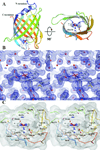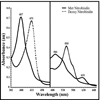The structure and NO binding properties of the nitrophorin-like heme-binding protein from Arabidopsis thaliana gene locus At1g79260.1
- PMID: 19938152
- PMCID: PMC2811769
- DOI: 10.1002/prot.22617
The structure and NO binding properties of the nitrophorin-like heme-binding protein from Arabidopsis thaliana gene locus At1g79260.1
Abstract
The protein from Arabidopsis thaliana gene locus At1g79260.1 is comprised of 166-residues and is of previously unknown function. Initial structural studies by the Center for Eukaryotic Structural Genomics (CESG) suggested that this protein might bind heme, and consequently, the crystal structures of apo and heme-bound forms were solved to near atomic resolution of 1.32 A and 1.36 A, respectively. The rate of hemin loss from the protein was measured to be 3.6 x 10(-5) s(-1), demonstrating that it binds heme specifically and with high affinity. The protein forms a compact 10-stranded beta-barrel that is structurally similar to the lipocalins and fatty acid binding proteins (FABPs). One group of lipocalins, the nitrophorins (NP), are heme proteins involved in nitric oxide (NO) transport and show both sequence and structural similarity to the protein from At1g79260.1 and two human homologues, all of which contain a proximal histidine capable of coordinating a heme iron. Rapid-mixing and laser photolysis techniques were used to determine the rate constants for carbon monoxide (CO) binding to the ferrous form of the protein (k'(CO) = 0.23 microM(-1) s(-1), k(CO) = 0.050 s(-1)) and NO binding to the ferric form (k'(NO) = 1.2 microM(-1) s(-1), k(NO) = 73 s(-1)). Based on both structural and functional similarity to the nitrophorins, we have named the protein nitrobindin and hypothesized that it plays a role in NO transport. However, one of the two human homologs of nitrobindin contains a THAP domain, implying a possible role in apoptosis. Proteins 2010. (c) 2009 Wiley-Liss, Inc.
Figures






Similar articles
-
The crystal structure of nitrophorin 4 at 1.5 A resolution: transport of nitric oxide by a lipocalin-based heme protein.Structure. 1998 Oct 15;6(10):1315-27. doi: 10.1016/s0969-2126(98)00131-2. Structure. 1998. PMID: 9782054
-
Ligand-induced heme ruffling and bent no geometry in ultra-high-resolution structures of nitrophorin 4.Biochemistry. 2001 Sep 25;40(38):11327-37. doi: 10.1021/bi0109257. Biochemistry. 2001. PMID: 11560480
-
Kinetics and computational studies of ligand migration in nitrophorin 7 and its Δ1-3 mutant.Biochim Biophys Acta. 2013 Sep;1834(9):1711-21. doi: 10.1016/j.bbapap.2013.04.009. Epub 2013 Apr 26. Biochim Biophys Acta. 2013. PMID: 23624263
-
Nitrophorins: nitrite disproportionation reaction and other novel functionalities of insect heme-based nitric oxide transport proteins.IUBMB Life. 2011 May;63(5):304-12. doi: 10.1002/iub.451. Epub 2011 Apr 13. IUBMB Life. 2011. PMID: 21491557 Review.
-
Ligand dynamics in heme proteins observed by Fourier transform infrared spectroscopy at cryogenic temperatures.Methods Enzymol. 2008;437:347-78. doi: 10.1016/S0076-6879(07)37018-3. Methods Enzymol. 2008. PMID: 18433637 Review.
Cited by
-
Ligand-Based Regulation of Dynamics and Reactivity of Hemoproteins.Biomolecules. 2023 Apr 17;13(4):683. doi: 10.3390/biom13040683. Biomolecules. 2023. PMID: 37189430 Free PMC article. Review.
-
Reductive nitrosylation of ferric microperoxidase-11.J Biol Inorg Chem. 2019 Feb;24(1):21-29. doi: 10.1007/s00775-018-1623-z. Epub 2018 Nov 2. J Biol Inorg Chem. 2019. PMID: 30390140
-
Lipocalin Blc is a potential heme-binding protein.FEBS Lett. 2021 Jan;595(2):206-219. doi: 10.1002/1873-3468.14001. Epub 2020 Dec 3. FEBS Lett. 2021. PMID: 33210733 Free PMC article.
-
Activating mutations and translocations in the guanine exchange factor VAV1 in peripheral T-cell lymphomas.Proc Natl Acad Sci U S A. 2017 Jan 24;114(4):764-769. doi: 10.1073/pnas.1608839114. Epub 2017 Jan 6. Proc Natl Acad Sci U S A. 2017. PMID: 28062691 Free PMC article.
-
Mycobacterial and Human Ferrous Nitrobindins: Spectroscopic and Reactivity Properties.Int J Mol Sci. 2021 Feb 7;22(4):1674. doi: 10.3390/ijms22041674. Int J Mol Sci. 2021. PMID: 33562340 Free PMC article.
References
-
- Gray HB, Winkler JR. Electron transfer in proteins. Annu Rev Biochem. 1996;65:537–561. - PubMed
-
- Ortiz de Montellano PR. Cytochrome P450: Structure, Mechanism, and Biochemistry. New York: Plenium press; 1995.
-
- Rodgers KR. Heme-based sensors in biological systems. Curr Opin Chem Biol. 1999;3(2):158–167. - PubMed
-
- Chan MK. Recent advances in heme-protein sensors. Curr Opin Chem Biol. 2001;5(2):216–222. - PubMed
-
- Olson JS, Phillips GN., Jr Kinetic pathways and barriers for ligand binding to myoglobin. J Biol Chem. 1996;271(30):17593–17596. - PubMed
Publication types
MeSH terms
Substances
Grants and funding
LinkOut - more resources
Full Text Sources
Molecular Biology Databases
Miscellaneous

